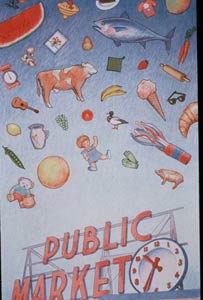 A Public Market is a year-round, carefully crafted, intentional and diverse medley of owner-operated shops, stalls and/or “daytables”.
A Public Market is a year-round, carefully crafted, intentional and diverse medley of owner-operated shops, stalls and/or “daytables”.
Public Markets exist to fulfill a public purpose, showcase a community’s unique character and culture while serving its everyday shopping needs.
They typically focus on the sale of a full array of fresh, healthful, value added, and prepared foods – often locally grown or produced. They are sometimes rounded out by crafts and/or a variety of needed neighborhood businesses. They usually include a seasonal, outdoor farmers market component.
Public Markets prohibit chain stores and franchises. They focus on businesses that are locally owned and operated which highlight the best of local foods, crafts, music, heritage and culture.
Typically, Public Markets are owned and operated by public or non-profit entities.
They exist for multiple public purposes, such as a job creation, small business incubator, tourist attraction, access to fresh, healthful foods, increase surrounding property values, historic preservation, etc.
Public Markets are powerful economic engines. They create entrepreneurial opportunities for citizens and immigrants who often find it difficult to enter into the mainstream economy.
Public Markets are potent job creators. In 1977, The federal Office of Technological Assessment (O.T.A.) conducted an audit of a $6,000,000 federal grant award to Seattle’s Pike Place Market from the Economic Development Administration (E.D.A.). They concluded that the Public Market renovation was the most successful community economic development project in the history of the U.S., at turning one time capital support, into long term, permanent, well-paying jobs.
 Public Markets are proven generators of surrounding, privately financed economic development. Historically, for example, at the Pike Place Market in Seattle, each dollar invested in Public Market renovation or development has generated more than twenty dollars in surrounding privately funded economic development. The neighborhood around Pike Place Market has been transformed from a “skid road” of derelict SROs, bawdy houses, and vacant buildings into one of the most vital, attractive, and successful, downtown communities in the country.
Public Markets are proven generators of surrounding, privately financed economic development. Historically, for example, at the Pike Place Market in Seattle, each dollar invested in Public Market renovation or development has generated more than twenty dollars in surrounding privately funded economic development. The neighborhood around Pike Place Market has been transformed from a “skid road” of derelict SROs, bawdy houses, and vacant buildings into one of the most vital, attractive, and successful, downtown communities in the country.
Similarly, the redevelopment of the Public Market in Roanoke, VA, has transformed a downtown known for crime, prostitution, and drug dealing into a successful downtown with several new surrounding bank towers and the successful renovation of the Roanoke Hotel (which had stood empty for decades) as a Convention Center.
Public Markets often incorporate a seasonal farmers market for the sale of “in season”, fresh, and value-added farm products sold on tables rented by the day. These ‘daytables’ are frequently augmented with locally made crafts.
Public Markets encourage diverse vendors that reflect the ethnic make-up of their communities. A mix of experienced vendors and start-ups is encouraged. Typically, training in display, marketing, etc. is provided to help new businesses prosper.
Public Markets typically require initial capital grant assistance. Once through their start-up period (typically about 3 years) they should be self-supporting and should not require ongoing operational support.
There are two different forms of Public Markets. Stand-alone Public Market buildings, also called Market Halls, such as Philadelphia’s Redding Terminal Market, and Public Market Districts that incorporate the above purposes and uses through zoning or other regulations in a larger, multi-building, defined area. Pike Place Market is an example of a Public Market District. It contains 11 acres and is carefully regulated to assure compatible uses, design, and signage in its fifteen mixed use buildings.
Public Markets typically include a farmers market which may be outside the Market building or incorporated into the Market.
These Markets encourage diverse vendors that reflect the ethnic make-up of their communities. A mix of experienced vendors and start-ups is encouraged.
Typically, training in display, marketing, etc. is provided to help new businesses prosper.
In Public Markets across the country, customers closely mirror the demographic makeup of the larger communities where the Market is located. Unlike malls – which are typically geared toward a particular economic and/or ethnic slice of the local population – Public Markets have historically proven their ability to cut across economic and racial lines in bringing together a broad cross section of the local population in a safe, lively, and exciting venue, where everyone feels welcome.
For example, according to survey data, 98% of the adults living within a 30 mile radius of Seattle’s Pike Place Market had visited the Public Market at least twice during the preceding year. Pike Place Market enjoys roughly 14,500,000 customer visits annually. In doing so, it supports over 120 local farmers and 250 local merchants.
In addition to attracting a broad cross section of the local population, Public Markets have proven their ability to become significant tourist attractions. The customer base at most Public Markets is roughly 1/3 tourists. In many of the cities where they are located, the Public Market is the #1 tourist attraction.
Sales at Public Markets typically will translate into many tens of millions of dollars in new revenue to local entrepreneurs, hundreds of new jobs, scores of entrepreneurial opportunities, and millions of dollars in new tax revenues.